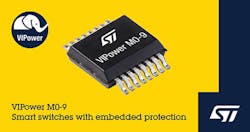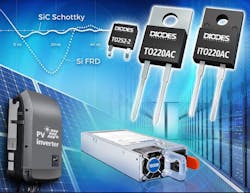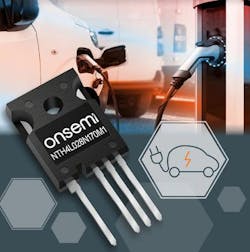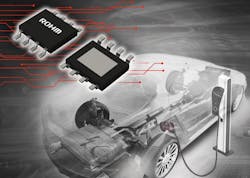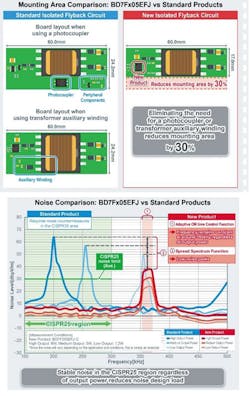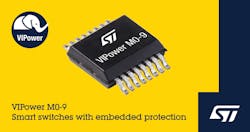This Week in PowerBites: Dueling Diodes, High-Side Hijinks, and Aviation Innovation
This article is part of the This Week in PowerBites Library Series.
A Powerful Collaboration to Create Smarter, More Sustainable Electric Motors
As a rule, PowerBites stories tend to focus on new products and technologies and leave business-related news to other outlets. However, we've made an exception in the case of Infineon's recently announced collaboration with Infinitum, one of our favorite advanced electric-motor manufacturers.
We originally reported on Infinitum's innovative air-core architecture, which uses a printed stator and integrated variable-frequency drive to produce a family of compact, lightweight, and highly efficient industrial motors in the May 13, 2021 issue of PowerBites. The company’s motors are 50% smaller and lighter, 10% more efficient, and use 66% less copper than traditional motors.
They’re also designed and manufactured to enable a sustainable, circular lifecycle: The motor’s modular architecture allows for the housing, rotors, and stators to be reused multiple times, giving parts a second and third life to serve future generations.
Infinitum's initial products seemed very promising, but we hadn't heard much more from the company. That’s until it was recently recognized with three 2023 CES Innovation Award designations for outstanding design and engineering in the sustainability and embedded technologies categories.
There's been even more exciting news since then, with the announcement of a strategic collaboration with Infineon Technologies to develop silicon-carbide (SiC)-based drive electronics solutions for its Aircore EC, smart industrial electric motor. Embedded in the motor, Infineon’s SiC solutions bring power switching of voltages at 650 V and above for a variety of applications to operate at high temperatures and in harsh environments.
“Infinitum’s groundbreaking motor controls and hardware enable next-generation solutions in industrial applications for some of the most rigorous environments,” said Michael Williams, Director of Product Marketing, Industrial Power Control Division, Infineon Technologies. “Infineon’s CoolSiC technology and motor-control expertise help Infinitum achieve improvements in energy efficiency and controllability over standard induction motors. We look forward to a long-term collaboration with Infinitum to bring next-generation energy-efficient motor controls to market with silicon carbide and other advanced materials.”
Additional details on the advantages of Infinitum printed air-core motors can be found in the downloadable whitepaper Endurance and Lifetime Assessment of PCB Stators.
Hybrid Power Drive Modules Simplify Electrification of Flight-Control Systems
Microchip Technology introduced a new family of hybrid power drive modules for use in electric flight-control systems targeting next-generation conventional and electric aircraft. The new product line is intended to make it easier for aircraft manufacturers to switch from hydraulic flight controls to all-electric systems to significantly reduce weight, space, complexity, and maintenance costs.
The integrated and configurable three-phase power module is the first variant of the new family and will be available in 12 different variants with either silicon-carbide (SiC) MOSFETs or insulated-gate bipolar transistors (IGBTs). The standard voltage of the power modules ranges from 650 to 1200 V, with the option to customize up to 1700 V on request. The device is designed with low inductance characteristics for high-power-density applications, with features that include power and signal connectors that are solderable directly on the user’s PCB.
Other key capabilities of these hybrid power drive modules include numerous auxiliary power devices that facilitate an inrush-current-limit function. Optional add-on capabilities include soft-start, solenoid interface drive, regenerative brake switch, and thermal sensors for external monitoring circuitry usage. The power modules also facilitate high-switching frequency power generation, which enables smaller and more efficient systems.
The hybrid power drive module is available in production quantities. For pricing and more information, contact a Microchip sales representative or visit Microchip’s Purchasing and Client Services website.
8-Channel High- and Low-Side Switches for Driving Loads in Industrial Apps
Two intelligent power products launched by Toshiba Electronics Europe are intended to control the driving of resistive and inductive loads, including motors, solenoids, and lamps, in applications such as programmable logic controllers within industrial equipment. The high-side (TPD2015FN) and low-side (TPD2017FN) switches are 8-channel devices that can be used in a complementary mode or in a standalone configuration. Both devices benefit from Toshiba’s latest analog device process (BiCD) that combines bipolar, CMOS, and DMOS technologies.
The demonstrated on-resistance (RDS(ON)) of both devices is 0.4 Ω—more than 50% lower than the previous generation of BiCD products, improving operating efficiency and thermal performance. The rugged power switches are able to operate at temperatures (Topr) from −40 to +110°C with a junction temperature (Tj) as high as +150°C, ensuring their suitability for challenging industrial environments.
In addition, both products have built-in overcurrent and overtemperature protection circuits, thereby ensuring the reliability of equipment they’re used in.
Each is housed in the 0.65-mm-pitch SSOP30 package measuring just 9.7 × 7.6 × 1.2 mm. This reduces approximately 29% in mounting area and 20% in height over the SSOP24 package (13.0 × 8.0 × 1.5mm) that’s used for current products such as the TPD2005F and TPD2007F. Both switches are in production and can be ordered through Toshiba's network of distributors. Datasheets for these two devices are available here and here.
Scalable High-Side Drivers Add Intelligence, Reliability to Non-Drivetrain Auto Apps
STMicroelectronics recently released single-, double-, and four-channel automotive high-side gate drivers in a common PowerSSO-16 package style, with pin assignments that simplify scaling circuit designs to add more driver channels. The gate drivers target applications throughout the vehicle, including safety, comfort, powertrain, body electronics, infotainment, and driver-assistance systems.
Meeting the automotive industry’s LV124 test schedule for deep cold cranking permits use with heavy loads, such as engine starters, and ensures reliable operation even in extreme winter conditions. With very low standby current at just a few microamps, these drivers minimize the drain on the battery when the vehicle is turned off and not being used.
The drivers are manufactured using ST’s proprietary VIPower M0-9 technology, which makes possible extensive integration within a small die size in addition to high current capability and high efficiency. On-chip features include protection such as load-current limiting, load-dump protection up to 3 5V, and limiting of fast thermal transients.
Flexible reset management lets the designer configure the driver’s responses to faults to best meet the needs of the application. The drivers provide reverse-battery protection through self-turn-on capability, which limits the power dissipation on the PCB to a survivable level.
Its diagnostic capabilities include high-accuracy proportional load-current sensing that enables detection of load malfunctions, such as an open LED string. The drivers also integrate fault detection for overload, short-to-ground, short-to-VCC, and off-state open-load conditions. All diagnostics are maintained whether the driver is turned on or off, permitting faults to be detected even when the load isn’t supplied.
The series comprises five single-channel drivers: VN9004AJ, VN9006AJ, VN9008AJ, VN9012AJ, and VN9016AJ. Dual-channel drivers include the VND9008AJ, VND9012AJ, VND9016AJ, and VND9025AJ. The VNQ9025AJ and VNQ9080AJ each have four channels. All are housed in the PowerSSO-16 package, which has a space-saving 6.00- × 4.9-mm footprint, is only 1.7mm high, and is pin-to-pin compatible. The drivers are also compatible with the previous-generation M0-7 family.
The VIPower M0-9 series drivers are in production now and available from st.com or distributors. Typical prices (1,000 pieces) range from $1.33 for the single-channel VN9004AJ, $0.95 for the VN9008AJ, and $0.97 for the VNQ9080AJ.
New Family of Silicon-Carbide Schottky Barrier Diodes Meets Efficiency Demands
Diodes Inc. announced the release of its first silicon-carbide (SiC) Schottky barrier diodes (SBDs). The portfolio includes the DSCxxA065 series with 11 products rated at 650 V (4, 6, 8, and 10 A) and the DSCxx120 series with eight products rated at 1200 V (2, 5, and 10 A).
These wide-bandgap SBDs bring the benefits of significantly improved efficiency and high-temperature reliability, while also responding to market demands for reduced system running costs and low maintenance. The devices are suitable for ac-dc, dc-dc, and dc-ac switching converters, photovoltaic inverters, uninterruptible power supplies, and industrial motor-drive applications. They also can be used in a variety of other circuits, such as boost converters for power factor correction.
The efficient performance of these SiC devices offer performance benefits that include:
- Negligible switching losses due to low capacitive charge (QC) that provide high efficiency in fast switching applications. This is suitable for circuit designs with higher power density and smaller overall solution size.
- Low forward voltage (VF) that further improves efficiency, lowering power losses and operational costs.
- Reduced heat dissipation that helps lower overall system cooling budgets.
- High surge current capability that increases robustness for better system reliability, while excellent thermal performance diminishes build costs.
Three package options include surface-mount TO252-2 (Type WX), through-hole TO220AC (Type WX), and ITO220AC (Type WX-NC). The DSCxxA065 and DSCxx120 series are available from $1.24 to $2.33 and $1.70 to $6.68, respectively, in 1,000-piece quantities.
1700-V SiC Devices Deliver Reliable Performance in Energy Infrastructure and Industrial Drives
Several new high-power products added to onsemi’s family of SiC devices, recently rebranded as “EliteSiC,” provide reliable, high-efficiency performance for energy infrastructure and industrial drive applications. The new members of the EliteSiC family include three 1700-V MOSFETs (NTH4L028N170M1) offering higher breakdown voltages (BV) required for high-power industrial applications. It also includes two 1700-V avalanche-rated SiC Schottky diodes (NDSH25170A, NDSH10170A) that enable designers to achieve stable high-voltage operation.
The devices address the unique requirements of industrial- and grid-scale renewable-energy applications that are moving to higher operating voltages, with primary buses in solar-power systems shifting from 1100 to 1500 V dc. To support this change, onsemi’s new EliteSiC MOSFETs offer a 1700-V BV rating and a maximum VGS range of −15 to 25 V, making it suitable for fast switching applications where gate voltages are increasing to −10 V, delivering increased system reliability.
At a test condition of 1200 V at 40 A, the 1700-V EliteSiC MOSFET achieves a gate charge (Qg) of 200 nC, which is market-leading compared to equivalent competitive devices that are closer to 300 nC, according to the company. A low Qg is critical to achieving high efficiency in fast switching, high-power, renewable-energy applications.
At a BV rating of 1700 V, the EliteSiC Schottky diode devices offer improved margin between the maximum repetitive reverse voltage (VRRM) and the peak repetitive reverse voltage of the diode. The new devices also provide high reverse-leakage performance with a maximum reverse current (IR) of just 40 µA at 25°C and 100 µA at 175°C—significantly better than competitive devices that are often rated at 100 µA at 25°C, said onsemi.
Isolated DC-DC Converters for xEVs Save Space, Minimize Noise Design Countermeasures
ROHM Semiconductor’s new BD7Fx05EFJ-C isolated flyback dc-dc converter (BD7F105EFJ-C, BD7F205EFJ-C) is optimized for gate-drive power supplies in xEV applications, such as electric compressors and PTC heaters. It provides the necessary isolation from the high-voltage primary source by using a circuit configuration that achieves stable switching-frequency characteristics without an photocoupler.
Based on ROHM’s unique analog design technology, the BD7Fx05EFJ-C eliminates the need for photocouplers, transformer auxiliary windings, and peripheral components that most converters need to detect secondary-side voltage and current.
In addition to eliminating the high power consumption, thermally variable detection accuracy, and deterioration over time associated with photocouplers, the new converter eliminates up to 10 discrete components typically required for current detection. As a result, it saves as much as 30% of the PCB area required to implement a conventional solution.
BD7Fx05EFJ-C isolated converters also are equipped with an adaptive on-time control function that fixes the switching ON time, ensuring a stable frequency of around 350 kHz regardless of output power.
To be compliant with the CISPR25 automotive EMC standard requires considerable noise reduction in the frequency range from 150kHz to 300kHz, but as ROHM’s new converters don’t fall within this band, noise countermeasures can be greatly simplified. This, together with a spread-spectrum function that minimizes radiated noise, contributes to reducing the number of efforts for noise design.
In addition, BD7Fx05EFJ-C devices improve application reliability by incorporating multiple protection circuits along with a function that stabilizes the output voltage.
Typical applications include:
- Automotive: electric compressors, PTC heaters, inverters
- Industrial: power supplies, PLCs, inverters
Availability and Ordering
The BD7Fx05EFJ-C family is in mass production now, available at Digi-Key, Mouser, Farnell, and other online distributors. Below are links for ordering the devices:
- Part numbers: BD7F105EFJ-CE2, BD7F205EFJ-CE2
- Evaluation board part numbers:BD7F105EFJ-EVK-001, BD7F205EFJ-EVK-001
Integrated Flyback Controller Boosts LED-Lighting Performance with Advanced Features
The HVLED101 90- to 400-V flyback controller developed by STMicroelectronics targets LED-lighting applications up to 180 W. It enhances performance and simplifies design through extensive feature integration, patented control techniques, and support for primary-sensing regulation.
Joining ST’s HVLED family of high-power-factor controllers, the HVLED101 contains 800-V startup circuitry that cuts the LED turn-on time to less than 250 ms. High-voltage input-sensing circuitry and a maximum-power-control (MPC) engine also are integrated to ensure consistent power output as the line voltage fluctuates. This lets designers choose smaller and lower-cost external passive components to handle worst-case line conditions. Primary-sensing regulation without isolated feedback further reduces the bill of materials and enhances reliability.
Among the patented innovations, ST’s input-current shaping algorithm lowers total harmonic distortion (THD) and maximizes the power factor. In addition, the HVLED101 is the first high-power factor flyback controller to implement ST’s new valley-locking technique to minimize audible noise, improve regulation, and reduce distortion. At steady state in quasi-resonant operation, valley locking fixes the number of valleys skipped until a significant change in output power or input voltage is detected.
Together, current shaping and valley locking enhance the power factor and THD even at low and medium loads. Flyback converters controlled with the HVLED101 can achieve 5% THD at full load and 10% at 1/3 load to meet leading ecodesign codes.
In addition, designers can program the delay time after zero-crossing detection in pure quasi-resonant operation using an external resistor. By ensuring gate turn-on at the lowest point of the valley, the HVLED101 minimizes energy losses and electromagnetic emissions (EMI). Overall, the HVLED101 enables converters to achieve maximum efficiency above 90% and no-load power below 100 mW.
All necessary protection is built-in, including overcurrent protection, input overvoltage protection, and brownout protection. There is also a smart auto-reload timer (ART) that allows latch-free operation of all protection mechanisms to ensure high reliability and a superior consumer experience.
Two demonstration boards containing the HVLED101 are available to jump-start development for faster time to market. The EVLHV101PSR50W is an 90- to 265-V ac, 60-V/0.8-A isolated flyback converter with primary-sensing regulation, while the EVLHV101SSR50W is a similar design with secondary-sensing regulation.
The HVLED101 is in production now in the narrow form-factor SO-14N package, priced from $0.99 for orders of 1,000 pieces.
Advanced 150-V MXT MOSFET for Light EVs Features Lower On-Resistance and TOLL Package
Magnachip Semiconductor launched its eighth-generation 150-V MXT trench MOSFET that’s optimized for light-electric-vehicle (LEV) motor controllers and battery-management systems (BMS). Thanks to its advanced design and leading-edge fabrication process, the MDT15N054PTRH has an RDS(on) that’s 28% lower than its previous generation of devices. Based on the enhanced design of the core cell and termination, it’s possible to achieve a high figure of merit and avoid an increase in the total gate charge.
The MDT15N054PTRH comes in a surface-mount TO-Leadless (TOLL) package to reduce product size and improve heat dissipation. Energy efficiency also is significantly enhanced by fast switching, while enabling high power density. In addition, a guaranteed operating junction temperature from −55°C up to 175°C and a high level of avalanche ruggedness help the new MXT MOSFET exceed the performance requirements of LEV motor controllers and BMS.
APEC '23 Power Conference Adds Professional Education Seminars to Program
In addition to its four-day schedule of technical forums, the Applied Power Electronics Conference (APEC 2023) conference will be offering two days of Professional Education Seminars that provide in-depth education on leading-edge power technologies and design practices. The seminars will be held on March 19-20 at the Orange County Convention Center, Orlando Fla., in parallel with the APEC conference that runs from March 19-23.
These in-depth seminars address practical aspects of the power electronics profession by covering complex topics—from the design of power systems to the application of the latest components. Each seminar talk is three-and-a-half hours long, with a typical 30-minute break in between. This extended time allows the speaker, or speakers, to lay the fundamental groundwork on their subject matter before initiating deep-dive discussions with attendees.
The Power Education Seminars will take place Sunday and Monday, prior to the APEC 2023 Plenary Session on Monday afternoon. Six topic tracks, running in parallel, are scheduled for three session times: Sunday, March 19 morning (9:30 am to 1:00 pm); Sunday March 19 afternoon (2:30 pm to 6:00 pm); and Monday, March 20 morning (8:30 am to noon). Click here for the full seminar program. Highlights include:
- “Switch Mode Power Concepts” – Presenter Robert White
- “Gate-Drive Circuit Design for Wide-Bandgap Power Transistors” – Presenter Eric Persson
- “Modeling, Measurement and Suppression of Conductive, Near-Field and Radiated Electromagnetic Interference in Power Electronics Systems” – Presenter Shuo Wang
- “The Essence of Solid-State Transformers” – Presenters Johann W. Kolar and Jonas Huber
- “Is SiC High Performance Technology Reliable Enough For Your Application?” – Presenters Xuning Zhang and Cesare Bocchiola
About APEC
As the premier event in applied power electronics, APEC focuses on the practical and applied aspects of the power electronics business. Not just a designer's conference, APEC has something of interest for anyone involved in power electronics.
For more information about APEC 2023, go to apec-conf.org.
Read more articles in the This Week in PowerBites Library Series.




